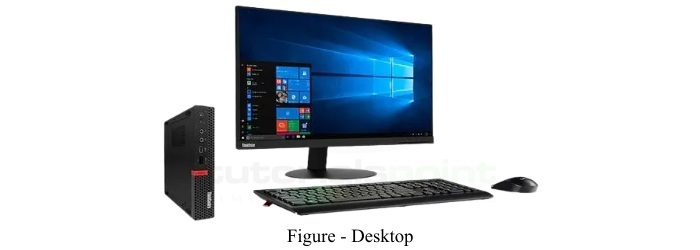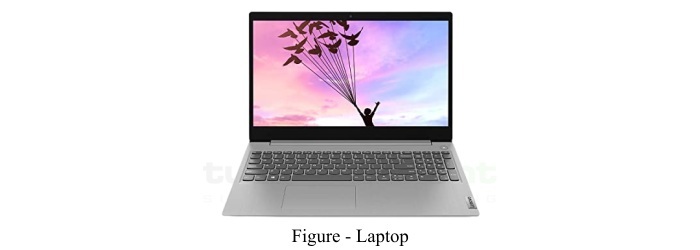
 Data Structure
Data Structure Networking
Networking RDBMS
RDBMS Operating System
Operating System Java
Java MS Excel
MS Excel iOS
iOS HTML
HTML CSS
CSS Android
Android Python
Python C Programming
C Programming C++
C++ C#
C# MongoDB
MongoDB MySQL
MySQL Javascript
Javascript PHP
PHP
- Selected Reading
- UPSC IAS Exams Notes
- Developer's Best Practices
- Questions and Answers
- Effective Resume Writing
- HR Interview Questions
- Computer Glossary
- Who is Who
Difference between Desktop and Laptop
We use computers to perform numerous works in offices, home, industries, etc. Several types of computers have been developed for different purposes. The two most common types of computers are desktop and laptop. Both desktop and laptop are the types of microcomputers used in almost every office and home.
The fundamental difference between desktop and laptop is that the desktop computer is a type of computer having its peripherals like mouse, keyboard, monitor, speakers, etc. connected together through wires and cables, therefore, desktop computers are non-portable computers. On the other hand, the laptop is a compact form of microcomputer in which all the parts are assembled in a single unit, hence, laptop computers are easy to carry from one place to another.
This article is meant for explaining the important differences between desktop and laptop. But before going to discuss the differences, let us first discuss a bit about desktops and laptops individually.
What is a Desktop?
A desktop is a type of microcomputer used to accomplish general purpose tasks such as office work, entertainment, homework, etc. A desktop computer is a computer system having peripheral components such as mouse, monitor, keyboard, CPU, etc. connected together through cables. Therefore, a desktop computer requires large space on a table/desk.

Desktops are to be powered directly from the supply mains, therefore they cannot be portable. Desktop computers are mainly designed to use at one location. Performance wise the desktop computers are highly efficient than laptops. The initial cost and maintenance cost of desktop computers are also less.
What is a Laptop?
A laptop is also a type of microcomputer. In the case of laptop, all the components of the computer like CPU, keyboard, mouse, speaker, monitor, etc. are assembled in a single unit. The laptops are powered by rechargeable batteries, therefore, they can be easily transported from one place to another.

However, laptops are slightly less efficient than desktops. Also, to have the same configuration, the laptop is more expensive than desktop. The maintenance cost of the laptop is also high. The major advantage of laptops is that they are portable.
After getting insights into the basics of desktop and laptop, let us now discuss the differences between them.
Differences between Desktop and Laptop
The following table highlights all the important differences between desktops and laptops ?
Parameter |
Desktop |
Laptop |
|---|---|---|
Device configuration |
In a desktop, different components such as monitor, CPU, keyboard, mouse, etc. are connected together with the help of wires. |
In laptop, all the parts of the computer system are assembled in a single unit. |
Physical size |
Desktops are larger in size. |
Laptops are smaller in size. |
Portability |
Desktops are non-portable computers. |
Laptops are portable computers. |
Power supply |
Desktops are directly powered from the AC mains outlet. |
Laptops are powered from a rechargeable battery. |
External keyboard and mouse |
Desktops require external keyboard and mouse. |
Laptops have built in keyboard and mouse. Although, we can also attach external keyboard and mouse with laptop as well. |
CPU |
Desktops have powerful CPU. |
Laptops have relatively less powerful CPU. |
Repair |
Desktops are easy to repair. |
The maintenance of laptops is a complex task. |
Initial cost |
For same system configuration, desktop computers are less expensive. |
Laptops are relatively more expensive than desktops. |
Screen size |
With a desktop computer, a monitor of any screen size can be connected. |
Laptops have limited screen size range. The use of large screen reduces the battery performance significantly. |
Component replacement |
In the case of desktop computers, components of the system can be easily replaced. |
The components of laptop are usually soldered on the motherboard. Therefore, they are no easily removable and replaceable. |
Input-output ports |
Desktops have more number of IO ports. |
Due to compact size, laptops have less number of IO ports. |
Weight |
Desktops are heavier than laptops. |
Laptops are light weight computers as they are designed to carry from one place to another without any inconvenience. |
Need of maintenance |
Desktops require less maintenance. |
Laptops require high maintenance and also they require expertise to fix the issues. |
Time to set-up |
Desktop takes more time to setup. |
Laptops require less time to setup |
Power consumption |
Desktops consume more power than laptop. |
Laptops consume comparatively less power. |
Upgradation |
In the case of desktop computers, upgradation is easier because it has removable components. |
Laptop has components fixed on the motherboard, therefore, they are usually not upgradable. |
Standard screen sizes |
For desktops, the standard screen sizes can be14 inches or more. |
For laptops, the standard screen sizes range from 10 inches to 17 inches. |
Applications |
Desktops are designed to regularly use at one location. Mostly, they are used in homes, offices, banks, colleges, computer labs, etc |
Laptops are designed to carry easily from one place to another. |
Conclusion
In conclusion, a desktop is a large sized microcomputer which is designed to use regularly at one location, whereas, a laptop is compact sized microcomputer which is designed for easy to carry purposes. The most significant difference between desktop and laptop is that in a desktop, the different components of the computer are connected together through cables, while in a laptop, all the components are assembled in a single unit.

